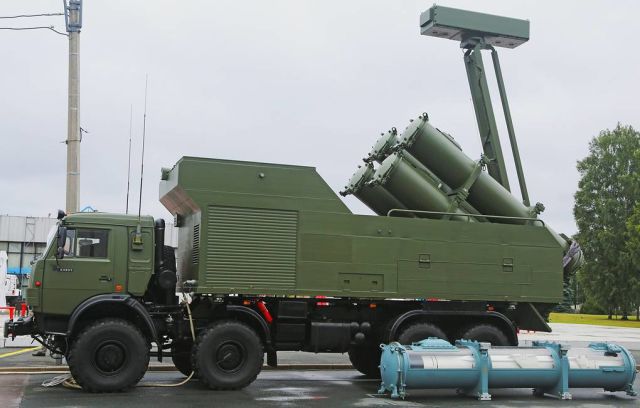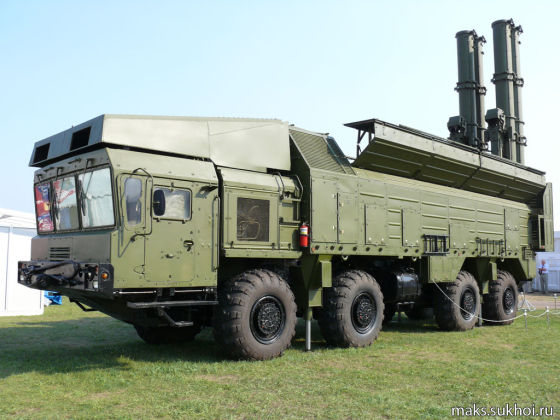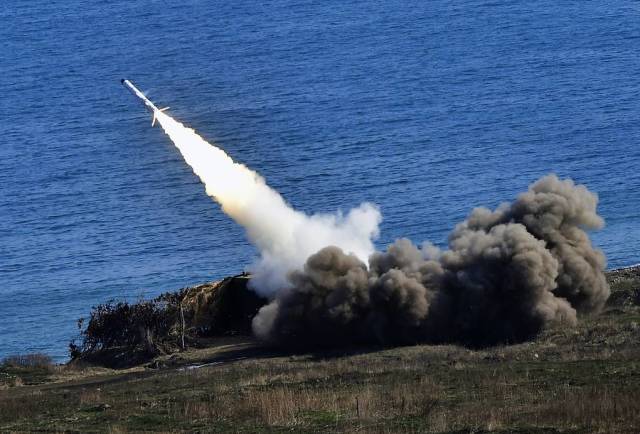Russian Bastion coastal missile systems (BRCS) hit ground targets with Onyx missiles during a special military operation, and the missiles themselves are being improved. About Russian missile defense systems and unique missiles — in the TASS material
The maritime border of Russia is twice as large as the land border and is more than 39 thousand km. To protect it, the Navy uses coastal missile systems "Bal" and "Bastion" with cruise missiles of various types. For example, the DBK Bastion fires a supersonic Onyx missile, which accelerates to 2,700 km/h. At the same time, the complex, the main purpose of which is ships, is capable of firing from the depths of the land and hitting various ground objects. This was noted by Alexander Leonov, General Director — General Designer of NPO Mashinostroenie (part of the Tactical Missile Armament Corporation). The head of the enterprise that produces cruise missiles added that engineers are actively working to significantly increase the range of the Onyx. Earlier, a TASS source close to the military department reported that the Onyx flight range is expected to be increased to 1 thousand km in the near future.
Rocket versus Ship
Domestic missile weapons to protect fortifications from enemy ships appeared a century and a half ago. It was developed by the Russian military inventor Konstantin Konstantinov. In 1848, on the initiative of Konstantinov and his associates, a battery of 22 rocket launchers was installed in one of the forts in Kronstadt. If an enemy squadron appeared, they could fire a heavy salvo. Tests have shown that the firing range is 2,600 m with satisfactory accuracy. In addition, a Russian artillery scientist, engaged in systematic research in the field of rocket technology, invented a ballistic pendulum, which made it possible to study the thrust of rocket engines. The design turned out to be so successful that it was used 100 years later at the Institute of Physical Chemistry of the USSR Academy of Sciences during the creation of Soviet solid-fuel missiles. Later, Konstantinov was appointed commander of the St. Petersburg Rocket Institution, where for the first time the production of combat missiles was ordered: three calibers were installed instead of many arbitrary ones, two types of ammunition — high-explosive and incendiary.
The development of aviation technologies in the post-war 1940s gave a new impetus to the development of such systems to protect the country's coasts. At that time, the United States had an aircraft carrier fleet with nuclear weapons carrier aircraft. As an asymmetric defensive response to the aggressive course of the United States and NATO, the Soviet Union began developing high—precision guided weapons - projectile planes. The term "cruise missile" appeared later. One such projectile with a radar homing head, launched from an airplane or a missile boat, is capable of sinking a large ship.
In 1955, the first launch of the Strela stationary coastal weapon system with a C-2 projectile aircraft took place from Cape Fiolent of the Crimean peninsula. The ammunition resembled the Comet projectile, adopted two years earlier and in layout really resembled a miniature MiG-15 jet fighter. The missile systems were located in protected underground structures, dubbed "Object 100". During one of the tests, the C-2 hit a barge at a distance of 70 km from the shore.
The rebirth of the "Cliff"
In the 1960s, the underground weapons system in Crimea was upgraded to a coastal missile system "Utes" with a cruise missile P-35. The complex was on combat duty, guarding the waters of the Black Sea, and even starred in the Soviet adventure film "Solo Voyage" directed by Mikhail Tumanishvili (1985) - there he played the role of an American underground missile base. After the end of the existence of the USSR, the unique object turned out to be on the territory of Ukraine, was transferred to the naval forces, and subsequently, according to media reports, was looted by hunters for non-ferrous metal. When the peninsula was reunited with Russia, the working capacity of the "Cliff" was restored . The firing range of the complex is 300 km, it is capable of operating together with modern DBK Bastion and Bal. Exercises are regularly held at the military facility. In the future, the complex may receive a new missile.
The stationary Strela was replaced in the late 1950s by the first mobile coastal missile system Sopka with a firing range of anti-ship missiles, according to various open sources, 40-95 km. He defended the maritime borders of the USSR in the Black Sea, the Baltic Sea, the Pacific Ocean and the northern latitudes. It was replaced by a more modern "Redoubt" with a supersonic cruise missile P-35. The complex belongs to the operational and tactical ones due to the firing range of 270 km.
The aforementioned complexes required a separate target detection radar. The mobile launchers of the Rubezh tactical missile defense system, which appeared in the late 1970s, were complete combat units - in addition to two P—15M cruise missiles, the vehicles also carried a radar. The Rubezh is capable of hitting surface targets at a distance of up to 80 km, while the missiles could have both radar and infrared homing heads. The complex was exported to a number of countries, including Algeria, Bulgaria, Vietnam, Egypt, Yemen, Cuba, and Syria.
Long-range and smart
Today, the coastal missile and artillery forces of the Navy are armed with modern DBK "Bal" and "Bastion".
The "Ball" consists of eight-shot launchers, transport and reloading vehicles that recharge the launchers after firing, as well as self-propelled command and control posts equipped with radars. The latter are able to detect enemy ships at a range of 100 to 450 km, depending on the type of radar station used. Bal is firing subsonic cruise missiles of the X-35 family. The range of the munition, depending on the modification, is up to 260 km, while the launchers can be located 10 km from the coastline. After launch, the rocket flies to the area of the specified target, and then turns on a miniature onboard radar (active radar homing head) and attacks the enemy ship at transonic speed and an altitude of several meters, and at any time of the day and in any weather. This makes it difficult to intercept a "smart" munition.
The same missiles are used by the "rocket boat on wheels" — the Rubezh-ME DBK. It carries four rounds of ammunition, but, like its predecessor, it has its own radar — that is, a machine with only two fighters is capable of acting independently. In addition, the new missile systems can operate in a group of up to eight vehicles, the total salvo of which will be 32 missiles.
 |
| The Rubezh-ME coastal missile system. |
| Source: © Nikolay Novichok/TASS |
The Bastion missile launcher carries supersonic Onyx missiles with a firing range of 300-500 km, according to various sources. The missiles launch vertically and then turn towards the target, that is, the launcher does not need to be aimed at the ship. The interval between the launches of two ammunition is 2.5 seconds, and the speed of the Onyx is 2.5 times the speed of sound.
"Onyx" in Indian
On the basis of the Onyx cruise missile (more precisely, its export version Yakhont), the Brahmos rocket of the joint Russian-Indian enterprise BrahMos Aerospace was designed. The company, which celebrated its 25th anniversary last year, was formed by the Reutov NPO of Mechanical Engineering (developer of the Zircon hypersonic missile, part of the Tactical Missile Armament Corporation) and the Defense Research and Development Organization of the Ministry of Defense of India. The company's name combines the names of two rivers - the Indian Brahmaputra and the Russian Moskva River. The Brahmos, like the Russian prototype, has supersonic speed, while it can be launched from a land-based mobile launcher, ships and submarines, as well as aircraft, and hit both surface and ground radio-contrast targets. Missiles are being upgraded, and their production is becoming more and more localized. Brahmos is exported - it was purchased by the Philippines, and the states of Southeast Asia, the Middle East and Latin America are interested in acquiring it. Currently, a new plant is being built in India, which will produce a new generation BrahMos-NG rocket. BrahMos Aerospace is the most ambitious joint defense project between Russia and India.
Such complexes are indispensable in the defense of island territories. For example, Bal and Bastion are deployed on the islands of Iturup and Kunashir in the Kuril Ridge to protect the strategically important Sea of Okhotsk.
 |
| The Bastion missile system. |
| Source: sdelanounas.ru |
Russian DBCS continue to improve. In 2022, TASS sources close to the Ministry of Defense of the Russian Federation reported that the Reutov NPO of Mechanical Engineering is creating a promising coastal missile system with a hypersonic Zircon missile. It is assumed that, like the Bastion, it will be able to hit both sea and land targets. According to Boris Obnosov, CEO of Tactical Missile Weapons Corporation, Zircon is capable of overcoming almost any air and missile defense system.
Victor Bodrov

